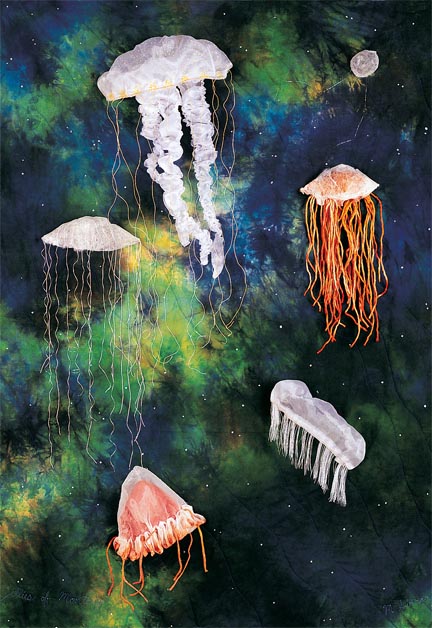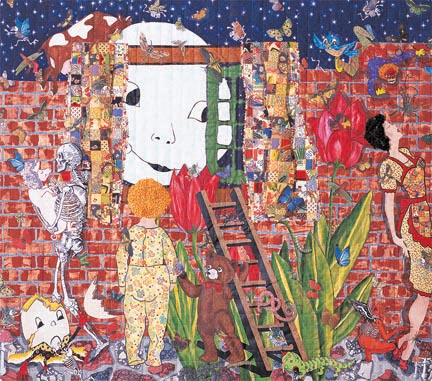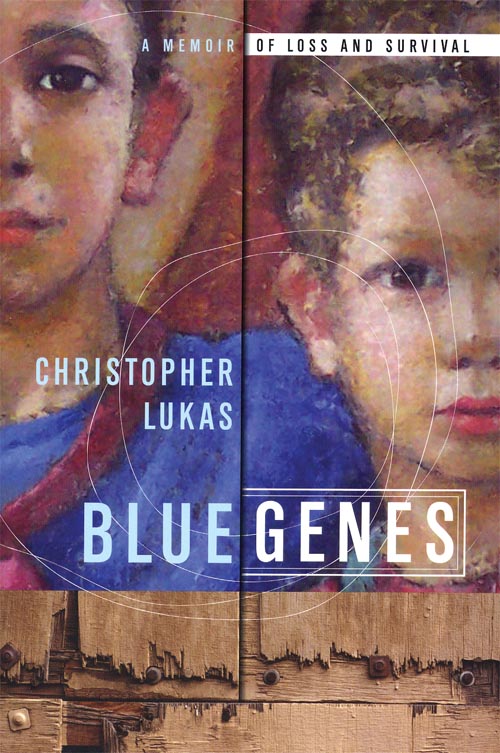A Feast of Quilts

Martha Sielman, Jellies of Monterey (2003), 41 x 31 x 3 inches. Hand-dyed cotton, silk, polyester cording, wire, paint; machine quilted, appliquéd. Sielman did not place herself among her book’s 40 master quilters but included an example of her own work in a biographical note. Missing from her book bio is the fact that her father, mother, sister, and husband all went to Swarthmore. She lives in Storrs, Conn., with husband David Shaiken ’82, five children (none of whom has shown any interest in attending the College—“yet,” she says), and two cats.
Martha Sielman ’82, author and curator, Masters: Art Quilts—Major Works by Leading Artists (Lark Books, 2008)
When people ask me how I got involved with art quilts,” writes Martha Sielman in her introduction to this sumptuous volume, “I tell them that it all began when I was very little and my mother let me play with the fabric scraps left over from sewing our dresses. Whenever I talk about playing with those scraps, my hands automatically start to mime touching the pieces—feeling the bumpiness of corduroy, the softness of velveteen, the slinky smoothness of sateen, and the crinkly quality of seersucker.”
Sielman made her first quilt in 1988 for her first baby. “I went to the Hartford [Conn.] Public Library and borrowed every book they had on quilting—all six of them.” Sielman may not have known it as she sewed an alphabet quilt made of pastel calico cottons, but the art of quilting was morphing from something for the bed to something for the wall. The “art quilt” movement—which got its start at the 1971 exhibit Abstract Design in American Quilts at the Whitney Museum of American Art in New York City—was exploding across the country.
“I made a quilt based on my own design in 1995, and I haven’t looked back,” writes Sielman. “Today, of course, books about quilting line shelf after bookstore shelf … but my history is fairly typical of the experience of many art quilters.”
In 2002, Sielman founded Fiber Revolution, a group of art quilters who work together to educate the public about art quilts and to find exhibition opportunities for quilters. In 2004, she became executive director of Studio Art Quilt Associates (SAQA), a fast-growing nonprofit membership organization dedicated to advancing fine-art quilting.
It is from this perch that she has created Masters: Art Quilts—a portable feast of quilts from 40 masters of the medium. Every artist is given about 10 pages of “exhibit space,” so the viewer can get a deeper understanding of the talents of each. The work ranges from the pictorial to the abstract, from hints of old patterns to pieces that look as if they are about to jump off the page.
Even first-rate photographs of these largely three-dimensional works can’t do justice to the textures, appliquéd objects, and unconventional materials favored by contemporary quilt artists. (One piece is made from aluminum roof flashing overstitched with orange plastic line from a weed whacker.) But this entire exhibit-in-a-book, which includes statements by each artist, makes me want to see these lush, colorful works in person.
Fortunately, I can do that. A traveling exhibit featuring one work by each of the 40 masters will visit five spots across the United States starting later this month in Houston (click here for list of upcoming exhibit locations). I can see photos of others at the SAQA Web site: www.saqa.com.
There may have been just six books on quilting in the Hartford Library in 1988, but librarians everywhere would do well to add this handsome volume to their collections for the next generation of fine art quilters to discover.
—Jeffrey Lott
View More Quilts and Read More of the Books + Arts section below

Jane Sassaman, Willow (1996), 75 x 75 inches. Machine appliquéd and quilted. Gardening is the inspiration for Sassaman’s work. She translates flowers into meticulously appliquéd designs that curl and coil around one another. “Most of my quilts are symbolic statements about the cycles and spiritual forces of life,” Sassaman says. “A plant travels the same cycle as a human: fertility, birth, maturity, death, and rebirth.”

Caryl Bryer Fallert, Flying Free #2 (1995), 93 x 82 inches. Created from cotton that has been hand dyed and painted, machine pieced and quilted, this work is from what the artist calls her “viewer participation” series—pieces characterized by the inclusion of her hand-dyed fabrics in a color-saturated,full spectrum to create a sense of sheer exuberance and joy. Brilliant colors fill the entire field of view, and swirls of quilting give texture to the designs. It is Fallert’s hope, she says, that her designs will lift the spirits and delight the eyes of those who see them.

Hollis Chatelain, The Gift (2006), 48 x 53 inches. Cotton, wool/polyester batting; hand-dye painted, machine quilted. Chatelain says that much of her work is influenced by personal experience. Her recent work depicts the people from countries she has visited, often displaying a distinct social agenda that promotes the importance of basic human rights, peace, clean drinking water, education, and protection from economic exploitation.

Wendy Huhn, Somnambulist (2003), 72 x 82 inches. Canvas, vintage fabrics, netting, heat transfers, phosphorescent medium, monofilament, beads; stenciled, painted, machine quilted, bound. An early love of paper dolls inspired Huhn’s work, yet the childlike images are juxtaposed with ominous ones, including skeletons, insects, snakes, and frightening clowns interacting with housewives, teddy bears, and children.
Robert Ellis ’56, A Collision of Truths: A Life in Conflict With a Cherished Faith, iUniverse Inc., 2008. With insight and poignancy, the author narrates his life story, including the events that led him to a deep personal struggle and later rejection of the Christian Science faith he was raised in and to which he was committed. Engaging and intimate, this spiritual adventure demonstrates that it is acceptable to question cherished spiritual convictions.
Tamar Chansky ’84, Freeing Your Child From Negative Thinking: Powerful, Practical Strategies to Build a Lifetime of Resilience, Flexibility, and Happiness, Da Capo Press, 2008. The author analyzes the underlying causes of children’s negative attitudes and provides numerous strategies to help parents and their children manage negative thoughts, build optimism, and establish emotional resilience.
Steven Schachter, William Mandell, Scott Harshbarger, and Randall Grometstein ’74, Managing Relationships With Industry: A Physician’s Compliance Manual, Academic Press, 2008. Members of the medical field will benefit from this elucidation of the ever-changing law and ethical standards on interactions with pharmaceutical and device companies. It is the first comprehensive summary of the law and ethics on physician relationships with industry written for the physician.
Tori Kearns ’97, Making the Call: Determining Who Qualifies as Learning Disabled in Higher Education, LRP Publications, 2008. The author relies on her own experience as a psychological examiner at the postsecondary level and as a provider of disability services in this reference work for those setting up and managing programs for students with learning disabilities.
Christopher Lukas ’56, Blue Genes: A Memoir of Loss and Survival, Doubleday, 2008. The author captures the devastation wrought by a family legacy of depression and suicide and the impact that both can have on those left behind.
Harvey Robbins and Robert Keighton ’53, If You Elect Me President: Behind the Scenes of a Presidential Election, Blue Hill Publishers, 2008. This work is an account of the effort to save historic Prowse Farm in Canton, Mass., and the authors’ involvement in the 1988 presidential election contest between George H.W. Bush and Michael Dukakis.
Kelly Terwilliger ’89, A Glimpse of Oranges, Finishing Line Press, 2008. This debut collection summons up a world of desire, loss, nature, things material and immaterial in poems with titles like “Jupiter and Saturn From the Driveway,” “My Father’s Glasses,” “The Dog’s Wake,” and “Painting by Vermeer.”
Nader Vossoughian ’95, Otto Neurath: The Language of the Global Polis, NAI Publishers, 2008. The author compiled this book in conjunction with the exhibit After Neurath: The Global Polis he curated in The Hague during spring 2008. The exhibit focused on sociologist and economist Neurath’s relationship with architecture and his influence on urban development.
John Pollock ’64, Tilted Mirrors: Media Alignment With Political and Social Change—a Community Structure Approach, Hampton Press, Inc., 2007. Rather than examining the impact of media on society, this book studies the impact of society on media, analyzing the ways in which communities influence the way media build perspectives on issues.
Nancy Robertson ’78, Christian Sisterhood, Race Relations, and the YWCA, 1906–46, University of Illinois Press, 2007. This analysis of black and white women’s struggles over race relations in the YWCA is based on lively autobiographical accounts and personal papers from women associated with the YWCA and a large body of records documenting the organization’s members.
Richard Weber ’41, Thumbnail Sketches: 29 Important Americans, Vantage Press, 2007. This work for middle to high-school–aged children offers brief biographies of politicians, industrialists, women’s rights advocates, authors, inventors, and others without whom life in the United States—from foreign policy to modern-day methods of production—would be quite different.
IN OTHER MEDIA
Paul Golub ’84 (director), La Puce à l’Oreille, Golub will direct a production of Feydeau’s classic farce on love and thwarted desire at L’Athénée Théâtre Louis Jouvet in Paris from Jan. 15 to Feb. 7 and throughout France until the end of April 2009.
B.(Bartlett) C. Jones ’54, Dr. Mary—Dang Contrary, premiere, Unitarian Universalist Church, Columbia, Mo., 2008. A retired professor of history and social science turned playwright debuted his play depicting the life of Mary Edwards Walker, the first and only female winner of the Medal of Honor and the first female U.S. Army surgeon to serve during the Civil War
 Email This Page
Email This Page



